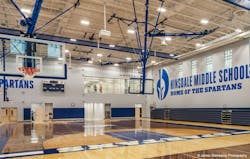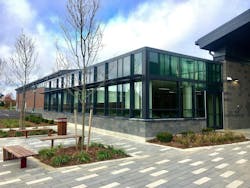Using Specialty Glazing Central to Achieve Safer School Design
According to a report from Glass Magazine, in the last year, 83 percent of surveyed glaziers were involved in projects that used fire-rated glass and 73 percent had installed ballistic-rated glass.
These types of specialty glazing can improve the ability for schools and other educational settings to provide safer, more secure spaces for teachers and students. Because specialty glazing can preserve access to daylight, improve sightlines, maintain code-compliance and achieve safer school design goals, it can be an integral part of new school builds and retrofits alike.
While understanding the larger concerns and frameworks behind safer school design is crucial for all project stakeholders, it is equally important to look to specific design examples. Doing so can help clarify what is possible with specialty glazing. Looking specifically at projects that use fire-rated glass, security-rated glass and multifunctional, fire-rated glass to meet unique project challenges can help direct successful designs.
Specialty glazing supports safer school design at Hinsdale Middle School and North Haven
In educational settings, fire-rated glass is one of the most commonly used specialty glazing materials. Fire-rated glazing systems can help meet egress requirements and support compartmentalization efforts—all while helping to visually connect adjacent spaces within the built environment.
This is evident in Hinsdale Middle School, where fire-rated glazing assemblies in multiple elevations maintain free egress in corridors and support transparent compartmentalization. The fire-rated glass used in this project is also impact safety-rated to meet ANSI Z97.1 and CPSC 16 CFR1201 (Cat. I and II) standards. As such, it can safely resist breaking from most collisions. This is crucial as a fire-rated assembly in one of the school’s busy interior hallways provides views into the gymnasium. Being able to withstand fire, smoke, flames and impact in these frequently traversed areas, this glazing contributes to a safer and more visually connected school environment.
In addition to fire-rated designs, specialty glazing, like forced-entry or ballistic-rated glass, can also support safer school designs. Security-rated glass can help visually connect interior spaces and be integral in efforts to monitor areas outside the building, like walkways and parking lots. However, the glazing in these areas can also be seen as weak links within the building envelope. To have a hardened exterior without compromising sightlines, many schools have turned to ballistic-rated glass—and many states have legislated building codes that require some form of hardening around the building perimeter. Achieving these requirements and goals efficiently can be a challenge.
While renovated before these legislations started becoming more common, North Haven Middle School offers a prime example. Transformed from a 1960s facility to a state-of-the-art learning environment, the school’s entry vestibule incorporates ballistic-rated glass to delay and deter active shooters from gaining access to the school. The bullet-resistant glass also allows views outside of the school to contribute to monitoring efforts.
Secure entry vestibules are primarily designed to contribute to access control and to support other aspects of safer school design. In addition, they can also be part of a means of egress system or be required to provide compartmentalization. If this is the case, it might be necessary for some parts of a vestibule to be fire-rated.
Gaffney Elementary School provides multiple forms of protection
Gaffney Elementary School was renovated in part to improve the school’s level of security. In line with this goal, the main office was reconfigured to allow more effective monitoring and a secure entry vestibule was designed to incorporate transparent security-glass. However, due to the design and the local building code requirements, the materials used within the vestibule needed to have a fire rating as well. This posed a challenge to the design team.
Most security-rated glazing products are plastic-based and burn quickly and intensely. When combined with fire-rated glazing, there is a risk that security components will compromise or negate the system’s fire rating. As such, it is necessary to specify multifunctional, fire-rated systems that either use components known to be compatible or are tested as a complete system to multiple test standards.
At Gaffney Elementary, specifiers turned to multifunctional, fire-rated glazing systems from Technical Glass Products (TGP) to enhance the level of security the school provided while also maintaining building code requirements for fire and life safety. This glazing creates a transparent, forced-entry barrier between the school’s main entrance and its central corridor. Now, front desk workers can safely monitor the interior and exterior of the school in real time safely. This supports the goal of having multiple time barriers to delay intruders.
As more jurisdictions adopt standards meant to improve the level of security a school provides, instances that need multiple forms of protection may increase. For example, if a Chicago-area school wished to install security-rated glass into its classroom doors, it most likely would need a glazing system that is also fire-rated. That is because this district requires all classroom doors leading to exit corridors to provide a fire rating regardless of the presence of sprinkler systems.
The push for safer school designs will likely continue to see attention in the coming years. Not only have states like Missouri, Texas and Tennessee signed bills to require enhanced security in schools, but the Glazing Industry Code Committee (GICC) has proposed additions to the International Building Code to address ingress as well as egress.
With these and other developments, it is important for building professionals to understand how different glazing components will interact within a system. Knowing this will help designers make more effective decisions in terms of occupant safety and security.



